This guide pulls from real-world inventory experiences with brands like Gap and fast-scaling Shopify stores such as Healf, so everything you read here is tested and proven.
In 2022, Gap Inc. faced a significant inventory challenge, ending the year with $3.04 billion in unsold products, a 12% increase from the previous year.
To address this, the company resorted to extensive discounting, which led to a five-percentage-point drop in merchandise margins, substantially impacting profitability.
If a global brand like Gap can end up with that level of overstock, it’s not far-fetched for your Shopify store to face the same.
Overstock doesn’t just mean shelves full of unsold products. It blocks your cash, adds storage costs, and creates a financial strain that grows month over month.
We’ll understand how overstock happens, the actual cost it brings to your business, and what you can do to prevent it.
Understanding Overstock Inventory
Overstock inventory happens when the amount of product sitting in your warehouse is more than what customers are actually buying.
This ties up cash that could be used for faster-moving SKUs, increases storage costs, and limits your ability to respond to real demand, all while putting pressure on your margins.
Let’s say you run an online pet supply store. You predict a jump in demand for a new type of eco-friendly cat litter and order a massive batch.
But customer reviews aren't great, and it never picks up. So you’re stuck with loads of cat litter in your warehouse, no one’s buying, and the money you spent on it isn’t coming back any time soon.
Now, why exactly did this happen? We found that below are some of the most common reasons for overstocks.
- Inaccurate demand forecasting: Demand planning that’s only based on past sales data or guesswork, without accounting for real-time data.
- Sudden demand drops: Trends shift fast. Economic changes, bad reviews, or a viral competitor can tank demand overnight.
- Supplier delays or overordering to meet MOQs: Buying more than needed to meet supplier minimums or placing large orders early due to unreliable lead times
- Overbuying for peak sales events: Expecting a rush during Black Friday or seasonal sales, but not hitting sales targets.
- Dead SKUs still in circulation: Outdated or underperforming products that no longer sell but continue to be restocked.
- Disconnected systems: Sales, inventory, and purchasing systems are not syncing, leading to poor stock decisions.
You might not notice it at first, but these overstock inventory challenges cost your business more than you think.
- Cash flow gets locked up: Every unsold unit holds your working capital hostage. According to the U.S. Census Bureau, retailers carried over $740 billion in inventory in late 2022, and a big chunk of that is excess stock
- Warehouse space gets wasted: Overstock fills up your storage, leaving less room for faster-selling products. The longer it sits, the more you pay for space that isn’t making money.
- Poor SKU performance messes up your data: Overstock SKUs skew your inventory and sales data, making it hard to see what’s actually working. They cloud your forecasts and ad campaigns, leading to costly mistakes.
- Discounting eats margins: To clear inventory, you end up running deep markdowns, which reduce the profitability of each sale and train customers to wait for deals.
How to Reduce Overstock Inventory (Practical Strategies)
If you're constantly running into overstock issues, it's not just a storage problem. It's a sign that the systems behind your inventory planning need a serious reset.
When implemented right, a few tactical strategies can help you not only manage excess stock but also prevent it. These include
1. Using accurate demand forecasting
It all starts with demand forecasting. If you get this part wrong, everything else that follows — from ordering to promotions to storage, spirals out of control.
Forecast too high, and you’re stuck with inventory that doesn’t move. Forecast too low, and you miss sales because your best sellers are out of stock. In both cases, your business loses money.
Accurate demand forecasting starts with accurate data. That means your sales, inventory levels, SKU performance, growth patterns, promotions, and seasonality trends need to be up to date and fully visible.
Apps like Prediko can help you achieve accuracy in forecasting. It syncs with Shopify in real-time and pulls in the last 12 months of historical data, seasonality, and growth trends.
Prediko’s forecasting is AI-based, so you’re getting dynamic restock alerts that adjust as your sales change. That means fewer stockouts, fewer overstocks, and a much clearer understanding of what to order and when.

With demand forecasting taken care of by ML and AI algorithms, there's less room for human error and more room to grow profitably.
Looking for the best demand planning software? We’ve rounded up the top options in this article.
2. Use just-in-time (JIT) approach
Just-in-time, or JIT, is a model where inventory is ordered and received only when it's needed, not months in advance.
The goal is to keep stock levels as lean as possible without disrupting fulfillment. You’re not stocking up just in case. You’re stocking up with intent, based on real demand.
This system was famously used by Toyota in its manufacturing process. They didn’t keep extra car parts lying around. Everything was scheduled to arrive right when production needed it.
This helped them cut storage costs, reduce waste, and respond faster to changes in demand.
Now, while eCommerce isn’t the same as car manufacturing, the principles still apply. You don’t need to store six months of slow-moving items in your warehouse. You just need to reorder the right products at the right time and in the right quantity.
If you're running a Shopify store, you can start applying a JIT-style approach by:
- Setting days of cover based on sales velocity
- Using real-time low-stock alerts to order right on time
- Choosing suppliers who can handle smaller, more frequent orders rather than large bulk shipments
- Tracking inventory by location to understand local demand better
It doesn’t have to be all-or-nothing. You can apply JIT to high-volume SKUs or seasonal products where demand is more predictable. Over time, you’ll carry less dead weight in your inventory, while still keeping your bestsellers available.
Prediko makes all this possible by giving you visibility into live sales velocity, sending automatic low-stock alerts, and dynamically adjusting reorder points.
It also supports multi-location tracking for precise demand forecasting. This way, you place smaller, smarter purchase orders exactly when you need them.
3. Use promotions and bundles to offload stock
Let’s be honest, customers are always ready for a great deal, whether it’s a bundle or freebie.
This is a great strategy to move excess inventory without resorting to steep discounts that can erode your brand's value.
Take Wayfair as an example. The company regularly runs large-scale promotions, but what’s interesting is how they structure them.
Most of the deals are set up so that suppliers cover almost all the costs, including discounts. That means Wayfair doesn’t take the hit alone and the inventory still moves.
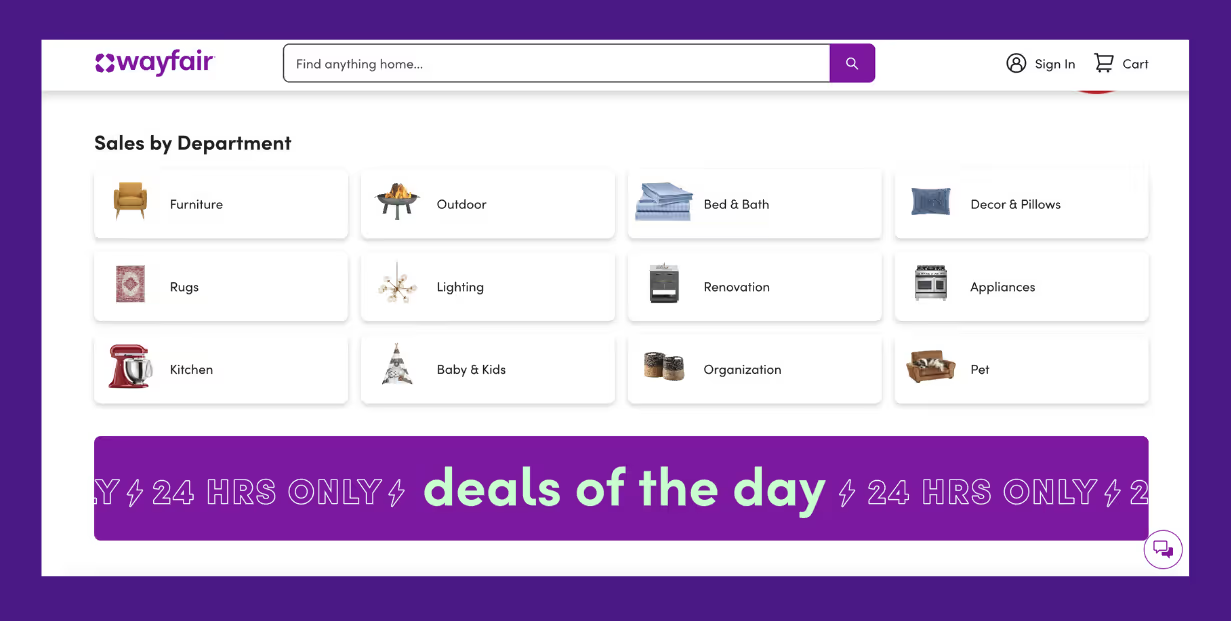
But the real win is shopper behavior. According to the Wall Street Journal, during these sales, around 70% of what customers buy isn’t even discounted. The offers just bring people in; once they’re browsing, they add full-price items to the cart too.
If you're looking to apply a similar approach to your Shopify store, consider the following
- Flash Sales: Time-limited discounts create urgency and can quickly reduce overstock
- Bundling Products: Combine slow-moving items with bestsellers to increase the perceived value and move inventory. For example, a skincare brand might bundle an unsold toner with a top-selling moisturizer at a slight discount.
- "We Made Too Much" Sales: Labeling overstock items as surplus from overproduction can maintain brand integrity while offering discounts. Brands like Lululemon have successfully used this approach.
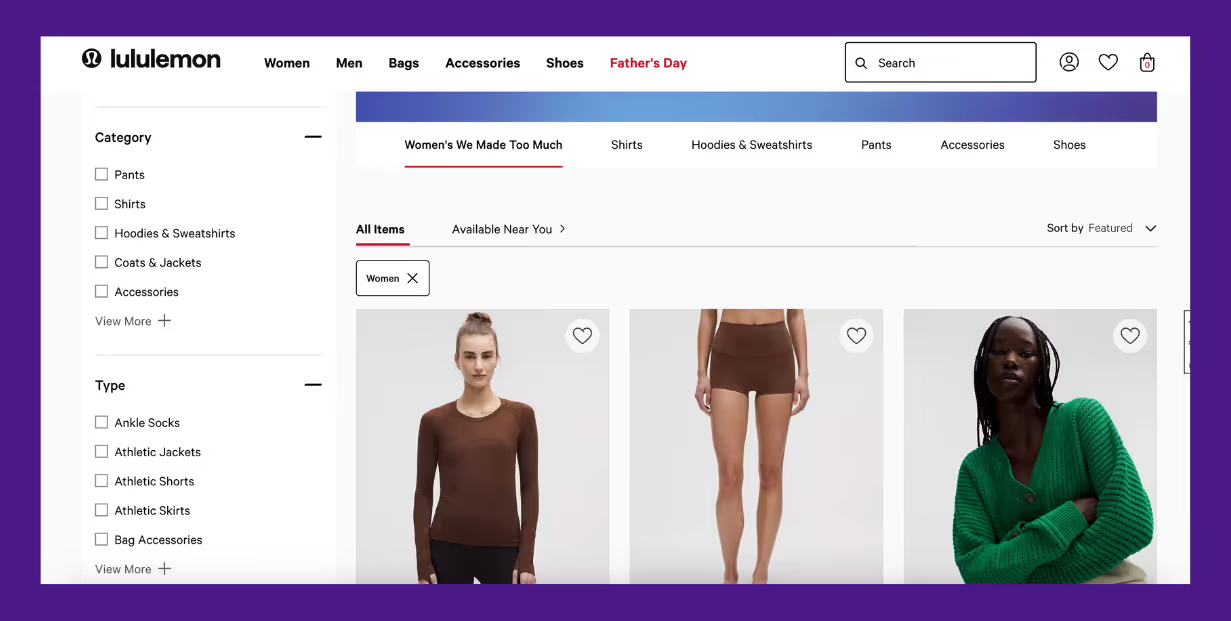
- Free Gifts with Purchase: Offer overstock items as complimentary gifts when customers reach a certain spending threshold, encouraging higher order values
Planning for peak season? Don’t miss our guide on how to build a winning inventory plan for the holidays.
4. Regular inventory reviews
Sometimes, overstock isn't caused by big forecasting errors or supplier issues. It just builds up slowly when inventory isn't reviewed often enough.
Products get added, SKUs stop performing, seasons shift, and what used to sell well six months ago starts gathering dust. If you're not checking in regularly, it’s easy to miss what's dragging down your inventory health.
Doing routine inventory reviews helps you catch all of that early. It shows you what needs to be reordered, what needs to be cleared, and what probably shouldn't be restocked at all.
These reviews don't need to be complicated or time-consuming.
Even a simple monthly or bi-weekly check of your SKU performance, sell-through rates, and storage levels can help you spot what’s not working before it turns into a bigger problem.
Prediko makes this easier by giving you automated reports on metrics like sell-through rate, COGS, overstock, inventory on hand, and more, so you can review performance without digging through spreadsheets.
Using Technology to Prevent Overstock Inventory
Manual systems break down fast once product lines grow and demand starts shifting.
Spreadsheets don’t update in real time, and you’re often making decisions based on numbers that are already outdated. That’s how overstock quietly builds up in the background.
That’s exactly what a UK-based wellness retailer, Healf, was facing before they switched to an inventory management software.
They were managing inventory through disconnected spreadsheets while juggling multiple SKUs and supplier timelines. These were the key issues they were up against:
- Inaccurate demand forecasting leading to surplus stock and missed sales
- High stockout rates that disrupted the customer experience
- Manual operations that took too much time and still lacked visibility
After switching to Prediko, the impact was quick and measurable:
- Stockouts dropped from 4% to 1% in just two months
- Over 10 hours saved every week on manual inventory tasks
- ROI reached 75x due to better forecasting and ordering precision
Healf didn’t hand over control to a tool. They made sure the repetitive tasks, tracking, updating, and flagging low stock, stopped taking up their time.
That freed them up to focus on decisions that actually moved the business forward, while Prediko handled the day-to-day mechanics in the background.
Read the full case study here.
You can also set your store up the same way and reduce overstock inventory using Prediko.
How Prediko Helps Reduce Overstock Inventory
Prediko is built for modern Shopify brands that want more control over their inventory without adding complexity to their workflow. It’s already trusted by 1,000+ Shopify stores looking to stay lean, accurate, and demand-ready.
If you're dealing with overstock or constantly reacting to inventory problems, Prediko offers you the features to get ahead of it. These include
1. Multi-location inventory tracking
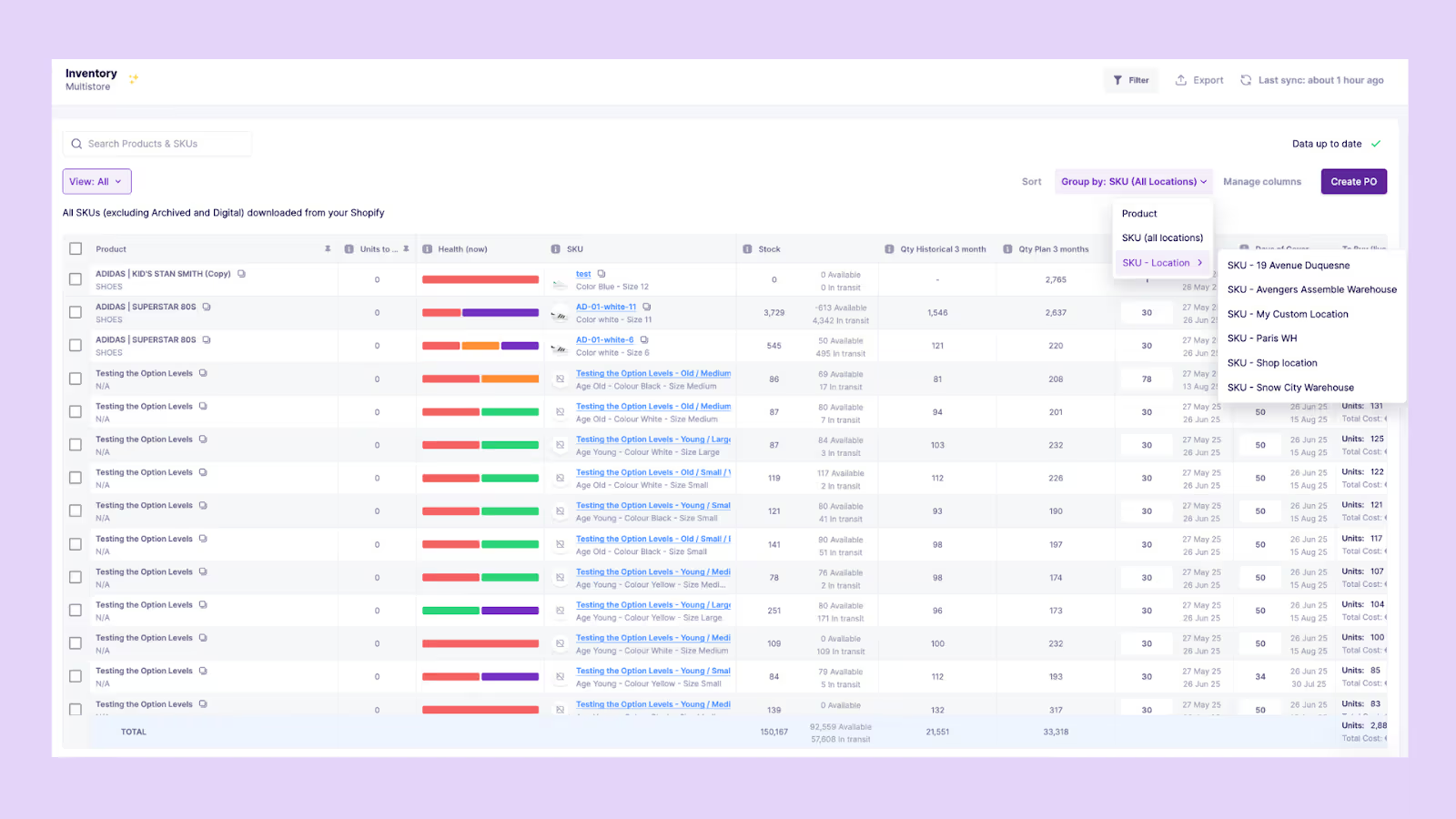
Lack of visibility into stock levels leads to over-purchasing, a key cause of overstocks for Shopify brands with multi-store sales.
You can track & manage inventory at the SKU, product, and category levels across suppliers, warehouses, and stores, all in one place.
Everything updates automatically, so you’re not stuck refreshing spreadsheets or relying on weekly reports.
2. AI-powered demand forecasting

Prediko solves one of the biggest causes of overstock: inaccurate demand forecasting.
It automatically pulls 12 months of historical sales data from your Shopify store to generate forecasts and updates them in real time as trends shift. You can plan both top-down and bottom-up, depending on how you manage sales targets.
You can also edit your forecast anytime, use custom filters to fine-tune it by product, location, or supplier, and compare actual revenue to planned revenue.
Inventory purchase suggestions appear directly in your Buying Tab, so planning and buying sit in the same workspace.
3. Purchase order management
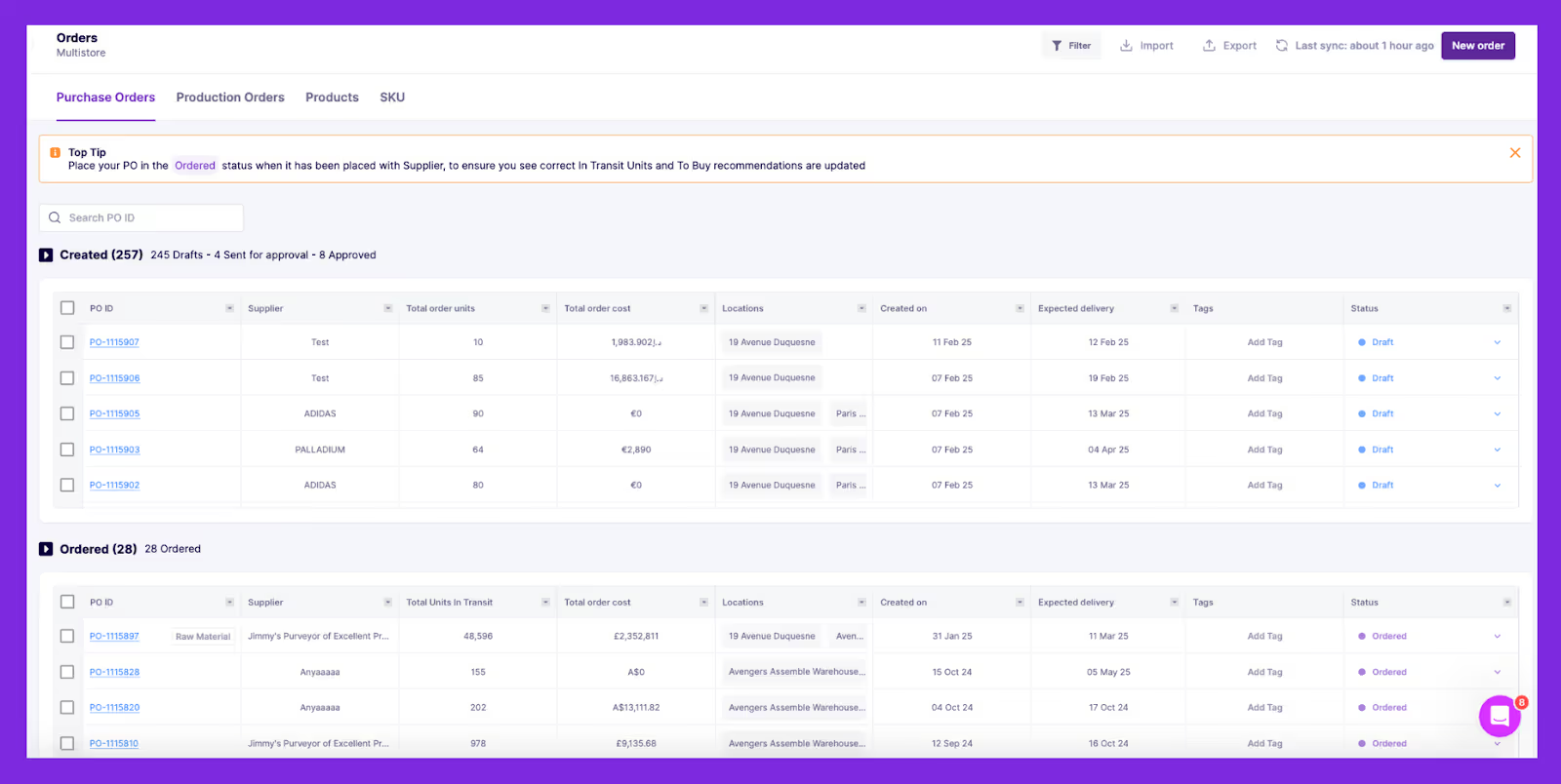
Prediko lets you create, review, and send purchase orders directly from the Plan & Buy tab.
It automatically suggests what to order, how much, and when, using real-time sales data, safety stock, and supplier lead times. You can also easily track the status of your POs.
This helps you avoid over-ordering during slow periods or missing restocks on fast-moving SKUs.
4. Inventory insights and reports
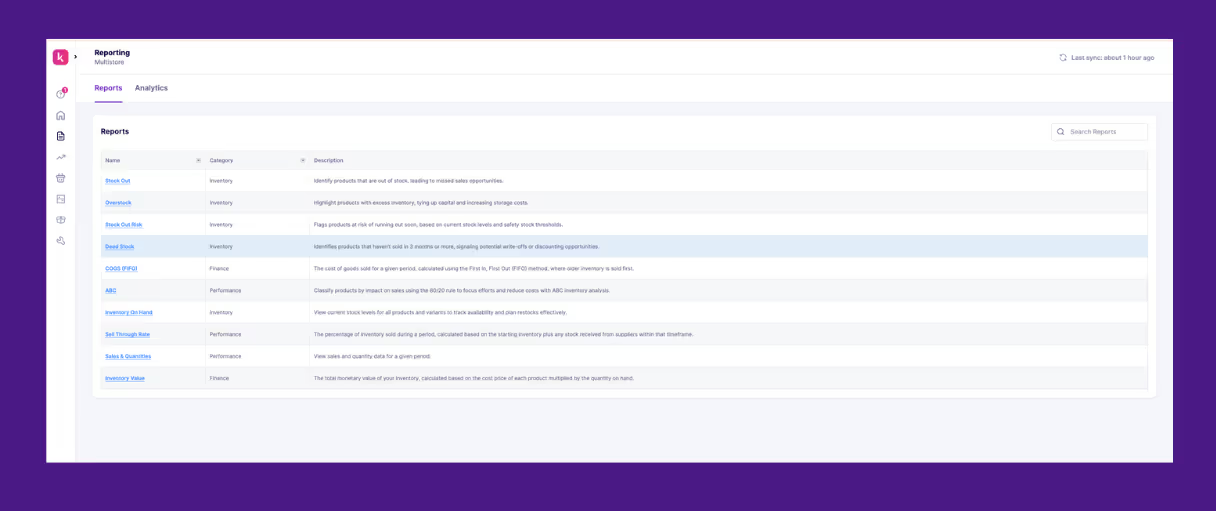
The app sends weekly performance reports and daily inventory alerts directly to your inbox so that you’re always in the loop of what’s piling up.
You get detailed reports on overstock SKUs, dead stock, stockouts, and location-wise performance, so you know how much stock is tied up, where it is, and which SKUs are at risk.
Automated low-stock alerts are triggered based on your lead times, safety stock, and days of cover, helping you proactively respond to inventory issues without manual checks.
5. Integrations
Prediko integrates with popular platforms, including WMS and 3PLs, so you don’t have to export CSVs or chase missing data across tools.
All your sales, inventory, purchase orders, and supplier updates are live in one system, reducing the risk of duplicate stock, missed reorders, and inaccurate decisions.
In short, it brings your entire supply process under one roof, from planning to ordering to reviewing performance.
This control is what helps fast-growing teams keep stock lean, accurate, and aligned with demand.
Take Control of Your Inventory Before It Controls You
Overstock and stockouts might seem like opposite problems, but they often stem from the same cause —a lack of visibility into what to order, when, and how much.
One leaves you with piles of unsold stock. The other means missed revenue and frustrated customers.
The right strategies and tools can help you avoid both. By replacing manual processes with a connected, unified system, you can keep your inventory balanced — not too much, not too little.
Prediko gives you complete visibility across your supply chain. From forecasting and purchase planning to tracking inventory performance, everything works together to keep you in control.
If you want to see what Prediko can do for your Shopify store, start with a 14-day free trial.
.svg)
.png)






